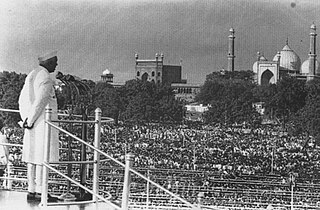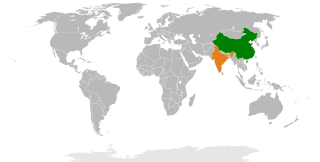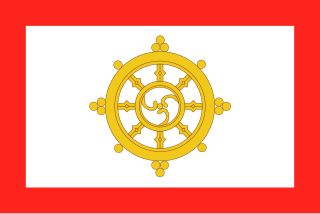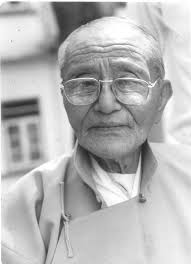| |||||
| Decades: | |||||
|---|---|---|---|---|---|
| See also: | |||||
The following lists events that happened during 1975 in Sikkim .
| |||||
| Decades: | |||||
|---|---|---|---|---|---|
| See also: | |||||
The following lists events that happened during 1975 in Sikkim .

Sikkim is a state in northeastern India. It borders the Tibet Autonomous Region of China in the north and northeast, Bhutan in the east, Nepal in the west, and West Bengal in the south. Sikkim is also close to India's Siliguri Corridor near Bangladesh. Sikkim is the least populous and second smallest among the Indian states. A part of the Eastern Himalaya, Sikkim is notable for its biodiversity, including alpine and subtropical climates, as well as being a host to Kangchenjunga, the highest peak in India and third highest on Earth. Sikkim's capital and largest city is Gangtok. Almost 35% of the state is covered by the Khangchendzonga National Park – a UNESCO World Heritage Site.
The abolition of monarchy involves the ending of monarchical elements in government, usually hereditary.

Palden Thondup Namgyal was the 12th and last Chogyal (king) of the Kingdom of Sikkim.
Events in the year 1975 in the Republic of India.

"51st state", in post-1959 American political discourse, is a phrase that refers to areas or locales that are—seriously or facetiously—considered candidates for U.S. statehood, joining the 50 states that presently compose the United States. The phrase has been applied to external territories as well as parts of existing states which would be admitted as separate states in their own right.

Indian nationality law details the conditions by which a person holds Indian nationality. The two primary pieces of legislation governing these requirements are the Constitution of India and the Citizenship Act, 1955. All persons born in India between 26 January 1950 and 1 July 1987 automatically received citizenship by birth regardless of the nationalities of their parents. Between 1 July 1987 and 3 December 2004, citizenship by birth was granted if at least one parent was a citizen. Individuals born in the country since then receive Indian citizenship at birth only if both parents are Indian citizens, or if one parent is a citizen and the other is not considered an illegal migrant.
The Sikkim State Congress, or SSC, was an annexationist political party in the Kingdom of Sikkim. It was founded in 1947 and worked closely with the Indian National Congress (INC) to successfully achieve the annexation of Sikkim to India. Other parties established by the INC to serve India's interests in its near abroad included the Nepal State Congress Party and the Bhutan State Congress Party.
Sikkim National Party was a political party in the Kingdom of Sikkim, formed in 1950. The Sikkim National Party was in favour of the monarchy and advocated independence for Sikkim. The party was founded to counter the growing influence of the pro-Indian parties Sikkim State Congress and Rajya Praja Sammelan, that had been formed after the independence of India in 1947.

The Chogyal were the monarchs of the former Kingdom of Sikkim, which belonged to the Namgyal dynasty. The Chogyal was the absolute monarch of Sikkim from 1642 to 1975, when the monarchy was abolished and its people voted in a referendum to make Sikkim the 22nd state of India.

The history of Sikkim, begins with indigenous Lepchas contact with early Tibetan settlers. Historically, Sikkim was a sovereign Monarchical State in the eastern Himalayas. Later a protectorate of India followed by merger with India and official recognition as a state of India. Lepchas were the main inhabitants as well as the Ruler of the land upto 1641. Lepchas are generally considered to be the first people, indigenous to Sikkim also includes Darjeeling.

The history of independent India began when the country became an independent nation within the British Commonwealth on 15 August 1947. Direct administration by the British, which began in 1858, affected a political and economic unification of the subcontinent. When British rule came to an end in 1947, the subcontinent was partitioned along religious lines into two separate countries—India, with a majority of Hindus, and Pakistan, with a majority of Muslims. Concurrently the Muslim-majority northwest and east of British India was separated into the Dominion of Pakistan, by the partition of India. The partition led to a population transfer of more than 10 million people between India and Pakistan and the death of about one million people. Indian National Congress leader Jawaharlal Nehru became the first Prime Minister of India, but the leader most associated with the independence struggle, Mahatma Gandhi, accepted no office. The Constitution adopted in 1950 made India a democratic country, and this democracy has been sustained since then. India's sustained democratic freedoms are unique among the world's newly independent states.

A salute state was a princely state under the British Raj that had been granted a gun salute by the British Crown ; i.e., the protocolary privilege for its ruler to be greeted—originally by Royal Navy ships, later also on land—with a number of cannon shots, in graduations of two salutes from three to 21, as recognition of the state's relative status. The gun-salute system of recognition was first instituted during the time of the East India Company in the late 18th century and was continued under direct Crown rule from 1858.
Bishwakarma or Viswakarma Brahman or Vishwabrahmin is an Indo-Aryan Nepali speaking group that primarily worked as metalsmiths. Later Nepal abolished its grading system. The tribal designation of Khas is given in only a few contexts to Bishwakarma. the Government of Nepal legally abolished the caste-system and criminalized any caste-based discrimination, including "untouchability" - in the year 1963 A.D. With Nepal's step towards freedom and equality, Nepal, previously ruled by a Hindu monarchy was a Hindu nation which has now become a secular state, and on 28 May 2008, it was declared a republic, ending it as the Hindu Kingdom. Even though it is illegal to discriminate people based on their caste, these people are widely discriminated in Nepal. A large portion of people who follow Hinduism still discriminate Kami and other so-called lower castes. While a small minority of the population claims that the problems related to caste based discrimination are no longer present in Nepal, many are fully aware that these problems are rooted not only in tradition and culture, but also religion. Caste based discrimination and violence are a grim reality of Nepali society with numerous people losing their lives due to racially motivated mobs. Both the Government and many other INGO are working hand-in-hand in order to uproot the problem by targeting grassroot issues such as education, awareness and employment.

The Nathu La and Cho La clashes, sometimes referred to as the Sino-Indian War of 1967, consisted of a series of border clashes between India and China alongside the border of the Himalayan Kingdom of Sikkim, then an Indian protectorate.

The Kingdom of Sikkim, earlier known as Dremoshong, was a hereditary monarchy from 1642 to 16 May 1975 in the Eastern Himalayas. It was ruled by Chogyals of the Namgyal dynasty.

The Sikkim Legislative Assembly is the unicameral state legislature of Sikkim state in north-eastern India. The seat of the Legislative Assembly is at Gangtok, the capital of the Sikkim state.
A referendum on abolishing the monarchy was held in the Kingdom of Sikkim on 14 April 1975. It was approved by 97.55% of voters, and resulted in the country becoming an Indian state.

General elections were held in Sikkim on 13 April 1974. They were the first elections in Sikkim to be held on the basis of universal suffrage, and also the last as an independent country. The result was a victory for the Sikkim National Congress, which won 31 of the 32 seats in the State Council. Kazi Lhendup Dorjee subsequently became Chief Minister. In May 1975 Sikkim became a state of India, at which point the State Council became the Sikkim Legislative Assembly.
Sangha is one of the 32 assembly constituencies of Sikkim, a state in the Northeast region of India. It is a part of the Sikkim Lok Sabha constituency. As of 2014, Sonam Lama is the holder of this seat. His current term is expected to end by 2024.

The State Council of Sikkim was the legislative body of the erstwhile Kingdom of Sikkim, which was located in the Himalayas, between India and China.